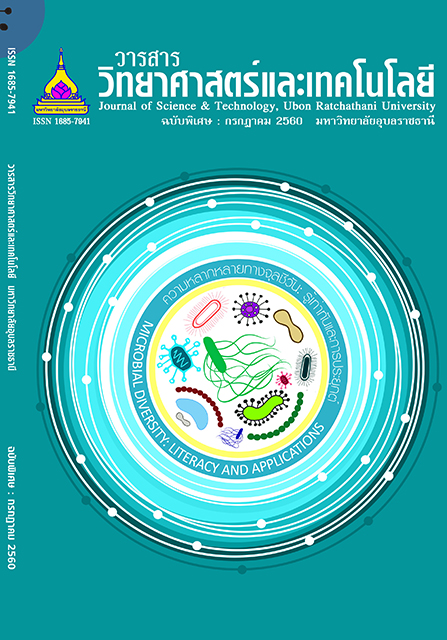การประยุกต์ใช้สารยับยั้งจุลินทรีย์จากแบคทีเรียกรดแลคติก ในการยับยั้งแบคทีเรียก่อโรคทางเดินอาหาร
Main Article Content
บทคัดย่อ
บทคัดย่อ
การศึกษาประสิทธิภาพของสารละลายส่วนใส (Crude Filtrate Supernatant Fluid; CFSF) จากแบคทีเรียกรดแลคติก ในการยับยั้งแบคทีเรียก่อโรคทางเดินอาหารของมนุษย์ 4 ชนิด คือ Escherichia coli TISTR 780, SalmonallaTyphimurium TISTR 292, Staphylococcus aureus TISTR 1466 และ Bacillus cereus TISTR 678 โดยวิธี Agar well diffusion เมื่อทำการทดสอบสมบัติแบคทีเรียกรดแลคติกทั้งหมด พบว่าไม่ผลิตสาร แบคเทอริโอซิน นำ CFSF จากแบคทีเรียกรดแลคติกมาบ่มที่อุณหภูมิและพีเอชแตกต่างกันเพื่อทดสอบความคงตัวการออกฤทธิ์ยับยั้งแบคทีเรียที่อุณหภูมิและพีเอชทดสอบและศึกษาค่ากิจกรรมในการยับยั้งแบคทีเรียก่อโรคทางเดินอาหารทั้ง 4 ชนิด พบว่า CFSF จากแบคทีเรียกรดแลคติกบางสายพันธุ์สามารถยับยั้งการเจริญของแบคทีเรียก่อโรคทางเดินอาหารทั้ง 4 ชนิดที่ทุกอุณหภูมิในแต่ละเวลาการบ่มแต่มีแนวโน้มการยับยั้งลดลงที่อุณหภูมิสูงในเวลาการบ่มที่ยาวนาน คัดเลือกแบคทีเรียกรดแลคติกที่มีค่ากิจกรรมการยับยั้งที่สูง 5 ไอโซเลต คือ S9B, M1A, M2A, G7B และ G8A เพื่อทดสอบการลดการปนเปื้อนของเชื้อแบคทีเรียก่อโรคทางเดินอาหารในกุ้งฝอย พบว่ามีเพียง 1 ไอโซเลตที่สามารถลดปริมาณของเชื้อแบคทีเรียก่อโรคทางเดินอาหารทั้ง 4 ชนิดได้ดีคือ ไอโซเลต G7B โดยสามารถลดปริมาณของเชื้อ Escherichia coli TISTR 780, Salmonalla Typhimurium TISTR 292 , Staphylococcus aureus TISTR 1466 และ Bacillus cereus TISTR 678 ได้ดีที่สุดที่เวลา 60 นาทีร้อยละ 92.24, 91.14, 74.89 และ 86.02 ตามลำดับ เมื่อนำแบคทีเรียกรดแลคติกไอโซเลต G7B ไปจำแนกสายพันธุ์โดยวิธีทดสอบทางชีวเคมี (ใช้ชุดตรวจวิเคราะห์ VITEK 2 compact) พบว่าแบคทีเรียกรดแลคติกไอโซเลต G7B คือสายพันธุ์ Lactobacillus plantarum
คำสำคัญ : แบคทีเรียกรดแลคติก แบคทีเรียก่อโรคทางเดินอาหาร
Abstract
The experiment was conducted to determine the efficiency of Crude Filtrate Supernatant Fluid (CFSF) of lactic acid bacteria, in inhibiting 4 species of food borne pathogenic bacteria; Escherichia coli TISTR 780, Salmonalla Typhimurium TISTR 292, Staphylococcus aureus TISTR 1466 and Bacillus cereus TISTR 678 by agar well diffusion method. After the experiment, Enzyme properties of these supernatants were tested and it was found that all supernatants were not a bacteriocin. Isolations were selected and tested for stability of pH and temperature conducted. Inhibition of food borne pathogenic bacteria from all supernatants were found at all temperature tested. However, inhibition of bacteria tended to reduce in longer period of incubation at high temperature. Inhibition efficiency of CFSF from isolations of lactic acid bacteria was studied. The best 5 inhibition efficiency of CFSF from lactic acid bacteria (S9B, M1A, M2A, G7B and G8A) were selected for examining the reduction of food borne pathogenic bacteria contaminated in Lanchester’s freshwater prawn. From the results, G7B was the best inhibition efficiency to reduce the contamination of food borne pathogenic bacteria at 60 mins (92.24%; Escherichia coli TISTR 780, 91.14%; Salmonalla Typhimurium TISTR 292, 74.89%; Staphylococcus aureus TISTR 1466 and 86.2%; Bacillus cereus TISTR 678). From the biochemical tests (VITEK 2 compact method), G7B was identified as Lactobacillus plantarum
Keywords: Lactic acid bacteria; Food borne pathogenic bacteria
Article Details
บทความที่ได้รับการตีพิมพ์เป็นลิขสิทธิ์ของ วารสารวิทยาศาสตร์และเทคโนโลยี มหาวิทยาลัยอุบลราชธานี
ข้อความที่ปรากฏในบทความแต่ละเรื่องในวารสารวิชาการเล่มนี้เป็นความคิดเห็นส่วนตัวของผู้เขียนแต่ละท่านไม่เกี่ยวข้องกับมหาวิทยาลัยอุบลราชธานี และคณาจารย์ท่านอื่นๆในมหาวิทยาลัยฯ แต่อย่างใด ความรับผิดชอบองค์ประกอบทั้งหมดของบทความแต่ละเรื่องเป็นของผู้เขียนแต่ละท่าน หากมีความผิดพลาดใดๆ ผู้เขียนแต่ละท่านจะรับผิดชอบบทความของตนเองแต่ผู้เดียว


